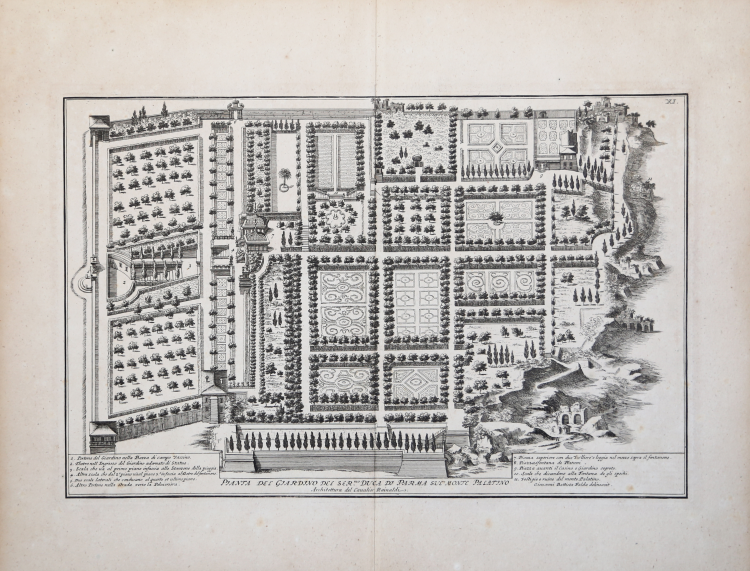



| Reference: | s12686 |
| Author | Joachim von SANDRART |
| Year: | 1685 ca. |
| Zone: | Orti Farnesiani |
| Printed: | Nurnberg |
| Measures: | 410 x 270 mm |


| Reference: | s12686 |
| Author | Joachim von SANDRART |
| Year: | 1685 ca. |
| Zone: | Orti Farnesiani |
| Printed: | Nurnberg |
| Measures: | 410 x 270 mm |
Plan of the Orti Farnesiani - the Farnese Gardens on the Palatine Hill.
Plate taken from Li giardini di Roma, disegnati da Giovanni Battista Falda...nuovamente dati alle stampe con direttione di Giov. Giacomo de Sandrart, published in Nuremberg by J. Von Sandrart around 1685 circa.
This work by Sandrart derives from the famous Li Giardini di Roma con le loro piante alzate e vedute in prospettiva disegnate ed intagliate da Gio. Battista Falda, edited by Gian Giacomo de Rossi a few years earlier (the first edition was certainly published after 1677 but before 1683) which included 19 plates of maps and perspective views of the most famous Roman gardens, 14 of which were engraved by G.B. Falda and 5 by Simon Felice.
The plates of this German edition, numbered in Roman numerals, were all engraved on the basis of the original ones, with a few variations, clearly evident in the comparison between the two works.
It is surprising, therefore, that this work by Sandrart is often mistakenly circulated under the name of Falda as the author; Paolo Bellini is also wrong in TIB stating that Sandrart used two original plaets by Falda.
For the plates Sandrart used his students as and many others artist as Karl Gustav von Amling (1650-1703); Philip Kilian (1628-1693); Richard Collin (1627-97); Georg Andreas Wolfgang (1631-1716); Johann Georg Waldreich (d.1680); Melchior Küsel (1626-1683); Franck, Johann (fl.1659-1690); George Christoph Eimmart (1638-1705); Susanna Maria von Sandrart (1658-1716); Bartholomäus Kilian (1630-1696).
Joachim von Sandrart was a painter of some note but it is for his Teutsche Academie that he is chiefly remembered. His compendious treatise includes sections on ancient sculpture and architecture, perspective, the theory of painting, artists’ biographies, a translation of Ovid’s Metamorphoses and so on. The second part of Book I purports to give a history of art from its earliest origins, and opens with an engraving of two scenes of legendary accounts of the discovery of drawing.
Etching with margins, very good condition.
References
National Gallery (Washington), Mark J. Millard, III (1998), no. 111; F.W. H. Hollstein, German engravings ... ca. 1400-1700 (1954-), 38-41; Anna Schreurs, Unter Minerva schutz: bildung durch kunst in Joachim von Sandrarts 'Teutscher Academie' (2012).
Joachim von SANDRART (Francoforte 1606 - Norimberga 1688)
|
German painter and treatises. Traveled extensively and was the most important German artist of the time but is remembered today almost exclusively for the "Teutsche Academie der Edlen Bau-Bild-und Mahlerey Künste" (German Academy of the noble arts of architecture, sculpture and painting) , published in Nuremberg in 1675-79 and followed by Latin edition in 1683. This treaty, organized into three main sections, is a source of great importance. The first part is an introduction to the art of architecture, painting and sculpture, mainly derived from earlier sources like Vasari and Van Mander. The second part, which contains biographies of artists, uses the same way as material from earlier sources, but also contains new material, especially on German artists and contemporary artists that the author knew personally (including Poussin and Lorrain). The third part contains information on art collections and a survey 'iconography, and finally there is also a chapter on the art of the Far East. Sandrart was the first director (1662) Academy of Nuremberg (the first in Germany).
|
Joachim von SANDRART (Francoforte 1606 - Norimberga 1688)
|
German painter and treatises. Traveled extensively and was the most important German artist of the time but is remembered today almost exclusively for the "Teutsche Academie der Edlen Bau-Bild-und Mahlerey Künste" (German Academy of the noble arts of architecture, sculpture and painting) , published in Nuremberg in 1675-79 and followed by Latin edition in 1683. This treaty, organized into three main sections, is a source of great importance. The first part is an introduction to the art of architecture, painting and sculpture, mainly derived from earlier sources like Vasari and Van Mander. The second part, which contains biographies of artists, uses the same way as material from earlier sources, but also contains new material, especially on German artists and contemporary artists that the author knew personally (including Poussin and Lorrain). The third part contains information on art collections and a survey 'iconography, and finally there is also a chapter on the art of the Far East. Sandrart was the first director (1662) Academy of Nuremberg (the first in Germany).
|